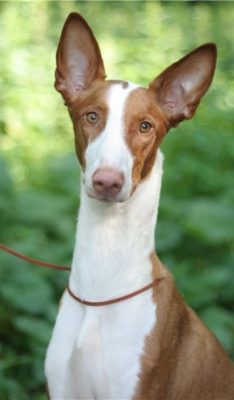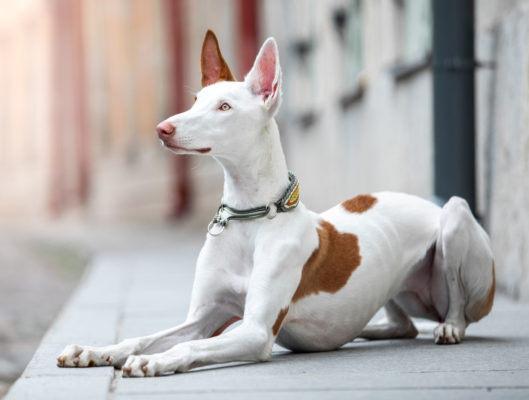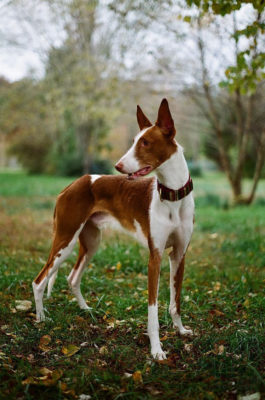Ibizan Hound

The Ibizan Hound has not only a unique appearance but also a versatile character. He can easily serve you as a courageous guardian and hunter, as well as a loyal friend for all family members. It treats strangers guardedly but without aggression. The relationship with children will be excellent because the Ibizan Hound is very agile and playful.
Table of Contents
Breed Information
| Another Name | Ibizan Warren Hound, Podenco Ibicenco |
| Origin | Ibiza (Balearic Islands, Spain) |
| Height | Males 66-72 cm Females 60-67 cm |
| Weight | 19-28 kg |
| Fur | Short |
| Color | Red and white, white, ginger |
| Lifespan | 12-14 years |
| FCI Classification | Spitz and primitive types |
| Group | Hunting dogs |
| Price | From $900 |
Breed Photos
Origin History
The Ibizan Hound is considered to be the most ancient greyhound of the Middle East. The images of dogs that are very similar in appearance to the Ibizan Hound have been found. Ancient drawings were also found in the Egyptian pyramids. It suggests that the progenitors of the Ibizan Hound may have been Egyptian pointed-eared dogs. Researchers believe that the breed was brought to the Balearic Islands by the Phoenicians, who then lived on the island of Ibiza. Hence the second name of the breed – Ibizan Hound.
The Ibizan Hound is quite popular in Menorca, Mallorca, around Valencia and Provence. Locals used the Ibizan Hound most often for hunting small game. Its closest relatives are the Pharaoh’s dog, the podenco canario, and the chirneco del etna.
There is a whole story about the Pharaoh dog. Initially, many cynologists called the Ivysky hound a Pharaoh dog because of its similarity with ancient Egyptian dogs. Then the breed was even registered in the English Club with that name. It was not until 1982 that the confusion of names came to an end, and the International Canine Federation officially registered the breed as an Ibizan Hound. In 2004, there were controversial points about the formation of the breed. Genetic studies have shown that the breed did not develop in such a long time, and the similarity with Egyptian dogs is only on the external level.
Appearance
The appearance of the Ibizan Hound can be called spectacular and memorable. It is a slender and strong dog. The physique is slightly stretched, with very long paws with developed muscles. The head is long and thin, small with the body. The skull is flat; the occipital part is protruding. The muzzle is elongated. Small almond-shaped eyes. The ears are diamond-shaped, sharply erect, and mobile, and large. The neck is long. A flat back. The tail is located low. The coat is smooth but rough to the touch. It is short but very dense. Do not allow for a pale color.
Character
The Ibizan Hound has not only a unique appearance but also a versatile character. He can easily serve you as a courageous guardian and hunter, as well as a loyal friend for all family members. It treats strangers guardedly but without aggression. The relationship with children will be excellent because the Ibizan Hound is very agile and playful.
The breed is very active. Some owners claim that the mayflies can jump three times their height. It is well suited for keeping in an apartment and your home. The only condition for keeping it in a private home will be some fenced area and a high fence so that the pet could not jump it and not get lost. It gets along well with other pets. Just remember that this is primarily a hunting dog. Do not forget to look after him and socialize him from an early age.
Also, the Ibizan Hound needs long walks with physical activity. And even better with energetic games. Take into account that the breed has incredible skills to take an acceleration of about 60 km/h. It runs fast and hard so that it will be a pleasant companion for your morning run or bike ride.
Care
The Ibizan Hound belongs to those dogs that are not very demanding in terms of grooming. A short-haired greyhound is enough to comb it out with a brush, and it is recommended to trim the dog with a stiff and thick type of hair several times a year. Due to its build and thin paws, additional insulation in the form of a warm suit or vest is necessary for the frosty season. Regularly monitor the cleanliness of the eyes and the condition of the ears. Nails should be trimmed twice a month if they do not shrink on their own.
Training
The pet is quite obedient and delicate. It will refuse to comply with the owner’s request only for a good reason. Suppose the dog is frightened, unsure of himself, or does not trust the owner at all. Start to nurture your pet slowly at an early age, preferably from three months of life. You need to help him not be afraid to obey commands and not respond with aggression to his failed attempts. Choose the most positive training methods you can to build up a rapport with your dog. Then you won’t have to wait, and he’ll be happy to give you a new command he’s learned.
Common Diseases
Although Ibizan Hound gives the impression of being a sturdy dog, he is prone to some illnesses:
- allergic reactions;
- congenital deafness;
- axonal dystrophy;
- epilepsy;
- various eye infections (progressive retinal atrophy, cataracts).
Nutrition
The Ibizan Hound is quite picky about food. She will not eat “just about anything“. Even from a perfectly prepared diet, it will choose only the tastiest things. Every season pick up the right vitamin supplements for her, which will contribute to the skeleton’s healthy formation. Diets for active medium breed dogs will do the trick. The great thing about the breed is that the Ibizan Hound is not prone to gaining excess weight.
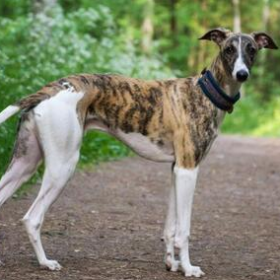 Greyhound
Greyhound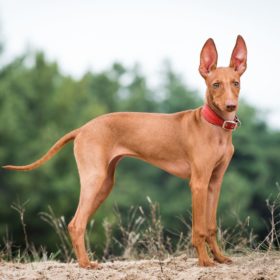 Cirneco dell’Etna
Cirneco dell’Etna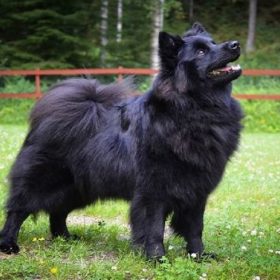 Swedish Lapphund
Swedish Lapphund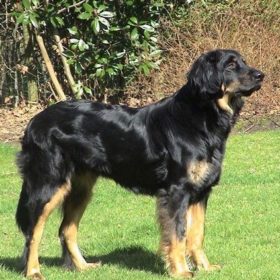 Hovawart
Hovawart Small Münsterländer
Small Münsterländer Bluetick Coonhound
Bluetick Coonhound